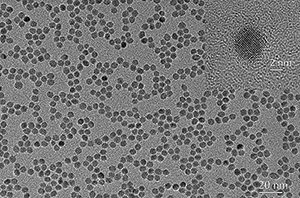Industry News July/August 2013
Peratech Touches Up QTC
Peratech, based in Richmond, England, recently launched the QTC Ultra Sensor, a touch-screen technology for OLED phone, monitor, and large, interactive displays (Fig. 1). Peratech claims that the new technology is so sensitive that it can detect finger touches on the front of the display when it is placed behind the OLED panel. The benefit to this is that having the touch-screen sensor behind the display allows more light to get through and thus enables a longer battery life.

Fig. 1: The QTC Ultra Sensor touch-screen technology from Peratech is designed for OLED
displays and works even when placed behind the OLED panel.
The new QTC Ultra Sensor technology is a follow-up to Peratech’s QTC Clear touch-screen technology that was launched in 2011. QTC stands for Quantum Tunneling Composite, which is a relatively new approach to force sensing. It is made from a polymer with nanoscale conductive particles. The particles have spikey surfaces from which electrons “leap” from one to another when a force such as pressure is applied. Information Display featured QTC in a Technology Preview in the January 2012 issue.
QTC is not currently being used in commercial display products, but QTC textile switches are already in use in about half a million high-end sport and ski jackets for controlling phones and I-pods in pockets. On the display front, Nissha has been working on using QTC in the front of displays (the two companies signed a licensing agreement in 2010) and several companies are currently evaluating the new behind-the-display technology, according to a Peratech spokesperson.
Amazon Buys Liquavista
In the weeks leading up to Display Week last May, news broke that Amazon.com had acquired Liquavista from Samsung Electronics Co. Liquavista, a company based in The Netherlands, has patented electrowetting technology that has for some time been considered a contender for color e-Readers. Neither firm has had much to say about the transaction (and neither responded to inquiries from Information Display), but Liquavista is now listed as “An Amazon company” on the Liquavista Web site. Samsung bought Liquavista in early 2011 for an undisclosed sum, and the price paid by Amazon has not been disclosed either.
The obvious-seeming conclusion is that Amazon will use Liquavista’s technology to finally produce a color e-paper product. But some commentators have questioned why Samsung would sell the technology if it was ready to be implemented in products. The answer may be that Amazon is more committed to e-Readers than Samsung, now that the e-Reader market has settled and even shrunk.
Paul Semenza, Senior Vice-President with NPD DisplaySearch, had this to say: “It was not clear to me whether Samsung acquired Liquavista [in 2011] to build e-Readers or to add to its display technology portfolio. For Amazon, one scenario could be a good-better-best strategy – the monochrome E Ink device, a color device with Liquavista, and the [LCD-based] Kindle Fire, which is moving to high resolution. The challenge is the price – unless Amazon starts giving away the E Ink devices, there is not much room between those and the Kindle Fire, and the cost of the Liquavista displays may be high, if only because Amazon is the only
customer.”
Neater Nanocrystals
Pixelligent Technologies, which makes nano-crystal additives for the electronics and semiconductor markets, recently announced PixClear Zirconia nanocrystals. When incorporated into existing products, these nano-additives can increase the light output and readability of touch screens and displays. PixClear also increases the light output of products for lighting applications such as HB LEDs and OLEDs (Fig. 2).

Fig. 2: A typical TEM (transmission electron microscopy) image of PixClear shows spherical nanocrystals with 5 nm size and narrow size distribution.
Pixelligent was developed to address the problem of nanocrystal dispersions that can suffer from aggregation and cloudiness and are unstable and difficult to process, preventing their commercial adoption. According to Pixelligent, its dispersions are completely clear and enable precise control over target applications’ optical, chemical, and mechanical properties.
Dispersion technology is a critical enabler for the manufacturing of very-high-quality nanocomposites used in a wide range of applications, including touch screens, OLEDs, and CMOS image sensors. Pixelligent’s PixClear nanocrystal dispersions have been tailored to be compatible with a wide variety of monomers and polymers. Its patent-pending synthesis and surface modification technology produces high-quality dispersions that can be incorporated into many of the most widely used polymer systems. This enables highly transparent formulations with nanocrystal loadings in excess of 80% weight, while reaching a refractive index as high as 1.85. Additionally, PixClear provides great flexibility for index matching of dissimilar materials.
Holographs Evolve
According to a recent article in the June issue of Nature, new modulators for holographic video displays are being tested that should enable better holographs, and even color ones. The paper’s authors, one of whom is V. Michael Bove, who wrote about holographic research in the article “Holographic Television at the MIT Lab,” in the November/ December 2012 issue of Information Display, suggest that this technology can be used as a platform for low-cost,
high-performance holographic video displays.
– Jenny Donelan